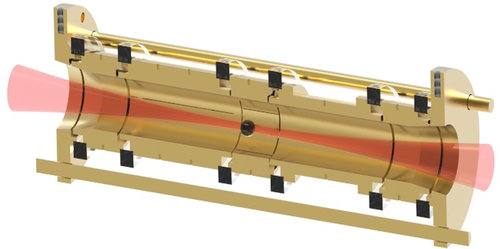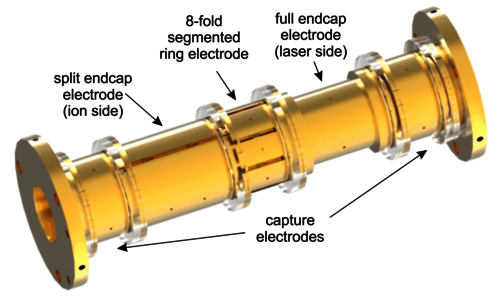HILITE
A Penning trap experiment for studies with atoms and ions in extreme laser fields
In photo-ionisation experiments at moderate light intensities, the number of photoelectrons emitted from matter is proportional to the light intensity. In our experiment, we study the highly non-linear process of multiphoton ionisation, where an atom or molecule absorbs many photons in one step. This non-linear process is a hot topic in laser research.
The interaction of highly intense radiation with matter and the corresponding non-linear effects have been subject of lively research, both theoretical and experimental, especially in the infrared and visible photon energy regimes. Laser systems capable of producing high intensities also at photon energies in the (soft) X-ray regime open access to novel effects like non-linear Compton effects or simultaneous elastic and inelastic photon scattering, and allow multiphoton-ionisation experiments in a new domain. We are currently commissioning and putting into operation a Penning-trap-based experiment for multiphoton-ionisation of confined particles by highly intense and highly energetic laser light.
The particles (atomic or molecular ions) are confined in a cylindrical Penning trap with conical outer electrodes for access also with highly focused laser light and are subjected to the laser light in a controlled manner. The reaction products are analysed in real-time by destructive and non-destructive methods. Such measurements are, for example, able to determine cross sections for multiphoton-ionisation in an energy- and intensity- regime so far not or not sufficiently examined. Additionally, the created electrons may be extracted from the trap and analysed externally. Hence, the reaction energetics may be reconstructed as completely as possible. The Penning trap setup is designed in a portable fashion, such that it can be attached to existing laser systems easily. Initial measurements have been performed at the FLASH laser facility at DESY, Hamburg.




- "Single-pass non-destructive electronic detection of charged particles", M. Kiffer, S. Ringleb, N. Stallkamp, B. Arndt, I. Blinov, S. Kumar, S. Stahl, Th. Stöhlker, and M. Vogel, Rev. Sci. Inst. 90, 113301 (2019)
- "HILITE - A tool to investigate interactions of matter and light", N. Stallkamp, S. Ringleb, B. Arndt, M. Kiffer, S. Kumar, T. Morgenroth, G.G. Paulus, W. Quint, Th. Stöhlker and M. Vogel,
X-Ray Spectrometry 2019; 1-4 doi.org/10.1002/xrs.3087 (2019)
- "Properties of a cylindrical Penning trap with conical endcap openings", S. Kumar, W. Quint, S. Ringleb, C.P. Safvan, N. Stallkamp, Th. Stöhlker, and M. Vogel, Physica Scripta 94 (7), 075401 (2019)
- "HILITE – Ion Trap for Studies with Intense Laser Pulses", S. Ringleb, M. Vogel, S. Kumar, W. Quint, G.G. Paulus and Th. Stöhlker, Journal of Physics: Conference Series 635(9), 092124 (2015)
- "A Penning trap for advanced studies with particles in extreme laser fields", M. Vogel, W. Quint, G. Paulus and Th. Stöhlker, Nucl. Inst. Meth. B 285 (2012) 65
- “High-intensity laser experiments with highly charged ions in a Penning trap”, S. Ringleb, M. Kiffer, N. Stallkamp, S. Kumar, J. Hofbrucker, B. Reich, B. Arndt, G. Brenner, M. Ruiz-Lopéz, S. Düsterer, M. Vogel, K. Tiedtke, W. Quint, Th. Stöhlker and G.G. Paulus, Phys. Scr. 97 (2022) 084002
- "Position-sensitive non-destructive detection of charged-particle bunches in low-energy beamlines", Stefan Ringleb, Markus Kiffer, Jonas K.C. Ballentin, Thomas Stöhlker and Manuel Vogel, Physics Reports 13, 22669 (2023)
- "Resistive cooling of ions’ center-of-momentum energy in a Penning trap on milli-second time scales", Markus Kiffer, Stefan Ringleb, Thomas Stöhlker and Manuel Vogel, Phys. Rev. A 109, 033102 (2024)
- “Off-resonance electronic detection and cooling of ions in a Penning trap”, Stefan Ringleb, Markus Kiffer, Thomas Stöhlker and Manuel Vogel, Eur. Phys. J. Plus 139, 401 (2024)




